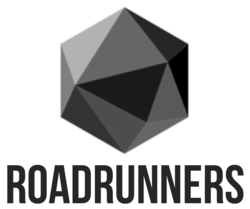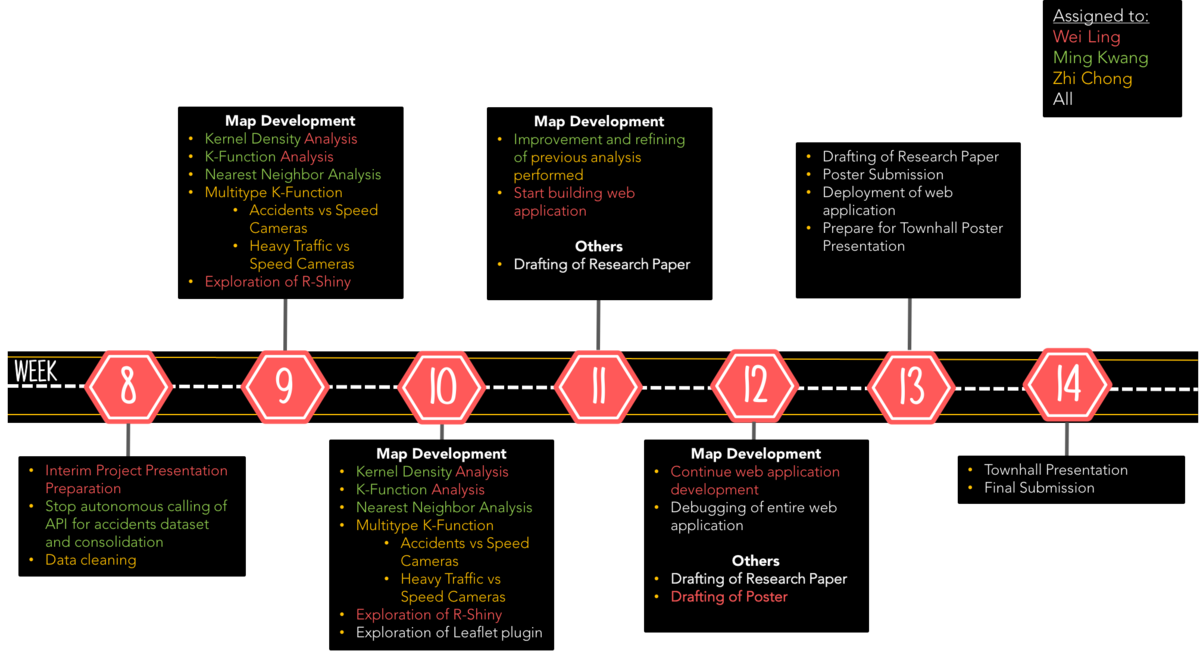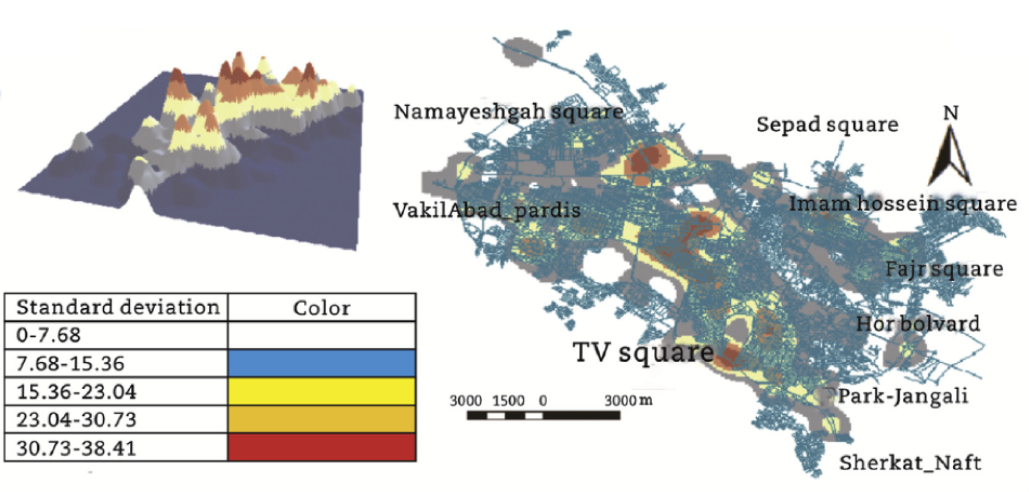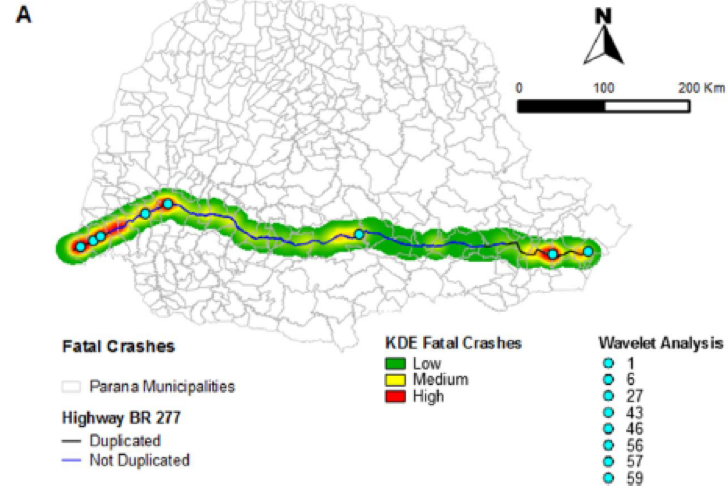Difference between revisions of "Roadrunners Proposal"
Wlgwee.2015 (talk | contribs) |
Wlgwee.2015 (talk | contribs) |
||
| Line 29: | Line 29: | ||
[[File:Projmot.png |800px|frameless|center]] | [[File:Projmot.png |800px|frameless|center]] | ||
| − | <div style="text-align: left; direction: ltr; margin-left: 1em;"><font face="Avenir">As a city-state that is scare of land, Singapore faces the challenge of a growing vehicle population. To address this issue, the Intelligent Transport System (ITS) aims to make the city-state’s transport system safer and more efficient. Some of these ITS solutions include the Expressway Monitoring Advisory System (EMAS) which monitors and alerts motorists of traffic incidents, and Electronic Regulatory Signs (ERS) which enhances the visibility of traffic signs. Under the Smart Mobility 2030 strategic plan, LTA hopes to pave the way for a more comprehensive and sustainable ITS ecosystem. | + | <div style="text-align: left; direction: ltr; margin-left: 1em;"><font face="Avenir"><big>As a city-state that is scare of land, Singapore faces the challenge of a growing vehicle population. To address this issue, the Intelligent Transport System (ITS) aims to make the city-state’s transport system safer and more efficient. Some of these ITS solutions include the Expressway Monitoring Advisory System (EMAS) which monitors and alerts motorists of traffic incidents, and Electronic Regulatory Signs (ERS) which enhances the visibility of traffic signs. Under the Smart Mobility 2030 strategic plan, LTA hopes to pave the way for a more comprehensive and sustainable ITS ecosystem. |
| − | While ITS aims to provide a safer experience for motorists, there is currently no known system in place to analyze the occurrence of traffic accidents. Traffic accidents are inevitable in any country and Singapore is no exception. They pose a huge problem to the safety of road users as they often result in fatalities and injuries. Therefore, our group aims to analyse the patterns of traffic accidents in Singapore and provide recommendations to reduce the occurence of traffic accidents in Singapore. | + | While ITS aims to provide a safer experience for motorists, there is currently no known system in place to analyze the occurrence of traffic accidents. Traffic accidents are inevitable in any country and Singapore is no exception. They pose a huge problem to the safety of road users as they often result in fatalities and injuries. Therefore, our group aims to analyse the patterns of traffic accidents in Singapore and provide recommendations to reduce the occurence of traffic accidents in Singapore.</big> |
</font></div> | </font></div> | ||
| Line 38: | Line 38: | ||
[[File:Projobj.png|800px|frameless|center]] | [[File:Projobj.png|800px|frameless|center]] | ||
| − | <div style="text-align: left; direction: ltr; margin-left: 1em;"><font face="Avenir"><strong>Through our project, we aim to: </strong> | + | <big><div style="text-align: left; direction: ltr; margin-left: 1em;"><font face="Avenir"><strong>Through our project, we aim to: </strong> |
#Detect patterns of traffic incidents in Singapore and identify potential accident hotspots | #Detect patterns of traffic incidents in Singapore and identify potential accident hotspots | ||
#Analyse potential causes of traffic incidents in Singapore | #Analyse potential causes of traffic incidents in Singapore | ||
| Line 45: | Line 45: | ||
#Possible recommendations to LTA to further reduce traffic incidents | #Possible recommendations to LTA to further reduce traffic incidents | ||
| − | </font></div> | + | </font></div></big> |
<br/><br/> | <br/><br/> | ||
| Line 129: | Line 129: | ||
[[File:Projwork.png|950px|frameless|center]] | [[File:Projwork.png|950px|frameless|center]] | ||
| − | <div style="text-align: left; direction: ltr; margin-left: 1em;"><font face="Avenir"> | + | <big><div style="text-align: left; direction: ltr; margin-left: 1em;"><font face="Avenir"> |
To gain a better understanding of how we could proceed with our analysis, we decided to conduct a literature review. Here are the summaries of some research paper on spatial analysis of traffic accidents: | To gain a better understanding of how we could proceed with our analysis, we decided to conduct a literature review. Here are the summaries of some research paper on spatial analysis of traffic accidents: | ||
<br/><br/> | <br/><br/> | ||
| Line 164: | Line 164: | ||
* Then developed regression models to evaluate the impact of built environmental components on fatal crashes | * Then developed regression models to evaluate the impact of built environmental components on fatal crashes | ||
</font></div> | </font></div> | ||
| + | </big> | ||
Revision as of 16:35, 4 February 2018
While ITS aims to provide a safer experience for motorists, there is currently no known system in place to analyze the occurrence of traffic accidents. Traffic accidents are inevitable in any country and Singapore is no exception. They pose a huge problem to the safety of road users as they often result in fatalities and injuries. Therefore, our group aims to analyse the patterns of traffic accidents in Singapore and provide recommendations to reduce the occurence of traffic accidents in Singapore.
- Detect patterns of traffic incidents in Singapore and identify potential accident hotspots
- Analyse potential causes of traffic incidents in Singapore
- Analyse traffic-related issues such as heavy congestions or roadworks
- Evaluate the effectiveness of accident prevention measures implemented by LTA
- Possible recommendations to LTA to further reduce traffic incidents
| Data | Source | Data Type/Method | |
|---|---|---|---|
| Road Network | OpenStreet Map | Example | |
| LTA Road Camera | data.gov.sg | SHP | |
| Singapore Police Force Digital Traffic Red Light Cameras | data.gov.sg | SHP | |
| Singapore Police Force Digital Speed Enforcement Cameras | data.gov.sg | SHP | |
| MCE KPE Speed Camera | data.gov.sg | SHP | |
| Singapore Police Force Mobile Speed Cameras | data.gov.sg | SHP | |
| Singapore Police Force Police Speed Laser Cameras | data.gov.sg | SHP | |
| Singapore Police Force Fixed Speed Cameras | data.gov.sg | SHP | |
| Bollard | data.gov.sg | SHP | |
| Convex Mirror | mytransport.sg | SHP | |
| ERP Gantry | mytransport.sg | SHP | |
| Lamp Post | mytransport.sg | SHP | |
| Road Crossing | mytransport.sg | SHP | |
| Speed Regulating Strip | mytransport.sg | SHP | |
| Guard Rail | mytransport.sg | SHP | |
| Railing | mytransport.sg | SHP | |
| Road Hump | mytransport.sg | SHP | |
| Traffic Light | mytransport.sg | SHP | |
| Traffic Sign | mytransport.sg | SHP | |
| Word Marking | mytransport.sg | SHP | |
| Accident | mytransport.sg | API → JSON → CSV Script to call API periodically to retrieve JSON file. Script converts JSON to CSV file. Attributes: Type::String Latitude::double Longitude::double Message::String | |
| Heavy Traffic | mytransport.sg | ||
| Key Challenges | Description | Solution | |
|---|---|---|---|
| 1. | Lack of readily available data | There is currently no known data source that provides historical traffic accidents data in Singapore. There is only a real time API of traffic accidents from LTA. |
|
| 2. | Unfamiliarity with R Shiny | We are unfamiliar with R programming language due to the lack of prior experience |
|
| 3. | Unfamiliarity with spatial analysis techniques | We are unsure what spatial analysis techniques to use and how to apply it as we lack prior experience in geospatial analysis |
|
To gain a better understanding of how we could proceed with our analysis, we decided to conduct a literature review. Here are the summaries of some research paper on spatial analysis of traffic accidents:
Aim of study: to use geographic information technology (GIS) and spatial-statistical analysis to gain insights of the traffic accident patterns in Mashhad, Iran.
Methodology:
1. Kernel Density Estimation
- To determine static hotspots
2. Nearest Neighbour Distance Analysis
- Used to determine if the accidents are clustered based on the nearest distance between two neighbouring accident points
3. K-function output analysis
- Used to provide a more accurate analysis of points distribution
Aim of study: to analyse road traffic accidents hotspots in BR 277 highway located in the state of Parana, southern Brazil and performed environmental analysis to identify patterns contributing to the traffic accidents.
Methodology:
1. Kernel Density Estimation
- To determine accident hotspots
2. Wavelet
- Complement Kernel exploratory analysis
3. K-function output analysis
- To reduce the variables into similar variance components
- Then developed regression models to evaluate the impact of built environmental components on fatal crashes









